The importance of fire door signs cannot be overstated. Over recent years fire safety has become a national topic of discussion in the UK following the Grenfell tragedy, and as a result, the processes, procedures, and measures we put in place to prevent such a disaster from occurring again, are firmly in the spotlight.
Fire door signs, whilst an often overlooked area of fire safety, play an important role in ensuring the safety of everyone within built environments.
In this article, we’ll explore everything you need to know about fire door signs in the UK, including the legal requirements, the different types of signs you might encounter, and all the things you need to consider when applying the correct signage to your fire doors.
Introduction to Fire Door Signs
The Significance of Fire Door Signs
Fire door signs play a subtle, yet vital role in fire safety within the built environment. They serve several crucial functions that include the following:
Identification: Fire door signs and door I.D. discs help identify fire doors, making it clear which doors should be used as part of a fire evacuation plan and which doors should remain closed or locked.
Instruction: These signs provide instructions on how to operate fire doors, whether they should be kept shut or clear, and whether they serve as emergency exits.
Safety: By conveying important information, fire door signs contribute to the overall safety of occupants during fire emergencies. Photoluminescent signs also guide the way or provide information for a short time if lights go out or in low light conditions.
UK Regulations for Fire Door Signs
Legal Obligations
Under UK law, the individual responsible for a building, whether it's the owner, manager, or employer, has a legal obligation to ensure that fire safety measures, including fire door signs, are in place and properly maintained. Failure to comply with these obligations can lead to fines or even imprisonment.
Key Regulations and Standards
The Regulatory Reform (Fire Safety) Order 2005 (FSO): This legislation places the responsibility on the "responsible person" to ensure fire safety measures, including adequate signage, are in place. In Scotland, similar regulations are outlined in the Fire (Scotland) Act 2005.
Fire Safety (England) Regulations 2022: Fire Door Guidance: This guidance came into force in January 2023 and implements many of the recommendations made to government from Phase 1 of the Grenfell Tower Inquiry. Amongst other things, it outlines the role of fire doors and notes that should be in good repair and in good working order.
BS 5499: This multi-part British Standard outlines the design, location, and use of fire safety signs, including fire door signs. Adhering to this standard ensures that fire door signs are consistent and easily understood.
BS EN ISO 7010: This regulation provides a design directive with a list of compliant graphical safety symbols to ensure consistency. BS EN ISO 7010:2020+A3:2022 details the meaning and look of safety signage.
Health and Safety (Safety Signs and Signals) Regulations 1996: Amongst other things, this regulation sets out the colour schemes for safety signage. It also includes reference to the above-mentioned BS EN ISO 7010.
These standards are in place to ensure consistency and effectiveness in conveying essential life safety information, and to provide guidance for the responsible persons and duty holders.
Proper Location and Placement
For fire door signs to be effective, they must be strategically located and placed for easy visibility. Here are some key considerations:
Height: Signs should be positioned at a height where they can be easily seen, typically between 1.5 meters and 2.0 meters from the floor so they are in a line of sight for most users.
Clear Line of Sight: Ensure that signs are not obstructed by objects, fixtures, or decorations.
Illumination: In areas with low-light conditions, illuminated signs or emergency lighting may be necessary. Photoluminescent signs only hold light for a short period, depending on the ‘charge’ they receive.
Consistency: Signs should have a consistent appearance throughout the building to avoid confusion and to provide clarity for all users.
Language and Symbols: Utilise clear and internationally recognised symbols, along with appropriate text, which may need to be in multiple languages. Braille signs should also be considered for visually impaired users.
Positioning: Depending on the type of signage and where it is positioned e.g. fixed to a door, wall, or ceiling, you may need to consider double-sided and hanging signage.
Types of Fire Door Signs in the UK
Fire door signs come in various forms, each serving a specific purpose. Let's explore the most common types of fire door signs you may encounter:
Fire Door Identification Signs
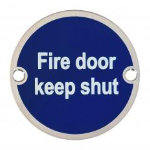 Fire Door Keep Shut Sign
Fire Door Keep Shut Sign
This sign reminds individuals to keep the fire door closed at all times. It displays the words "Fire door keep shut" in white lettering on a blue background. These are fitted to fire doors that have a door closer fitted.
 Fire Door Keep Locked Sign
Fire Door Keep Locked Sign
This sign is for fire rated doors that are kept locked in normal use. These doors would not have a door closer installed as their usual state would be to remain locked, usually with a mechanical locking device rather than access control. These signs have white text on a blue background.
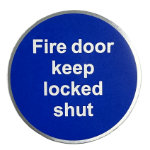 Fire Door Keep Locked Shut Sign
Fire Door Keep Locked Shut Sign
Another type of mandatory fire signage featuring white text on a blue circular background. These signs could be a metal disc, rigid plastic square, or self-adhesive vinyl. White lettering reads: “Fire door keep locked shut”.
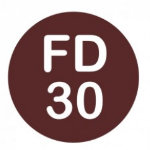 Fire Door Identification Discs
Fire Door Identification Discs
These small discs are used to identify the fire rating of doors in public buildings. Either face fixed or routed in, these brown discs with white lettering denote either FD30 or FD60 rated fire doors.
Fire Door Keep Clear Signs
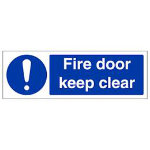 Fire Door Keep Clear Sign
Fire Door Keep Clear Sign
This sign instructs people to maintain a clear area around the fire door, free from obstructions. It is a mandatory sign so features a blue rectangular background, with the words "Fire door keep clear" in white lettering.
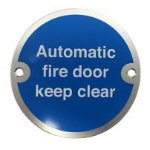 Automatic Fire Door Keep Clear Sign
Automatic Fire Door Keep Clear Sign
This fire door sign is for use on doors that have electromagnetic door closers or door holders installed. This mandatory blue circle fire safety sign is for use on doors that are magnetically held open or have door closers with swing free function.
Egress Instruction Signs
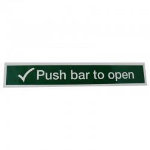 Push Bar to Open Sign
Push Bar to Open Sign
Found on doors equipped with panic bars, this sign informs users that they should push the bar to open the door in an emergency. It typically displays a white image of a hand pushing a bar on a green rectangular background, with the words "Push bar to open" in white lettering. This is for doors with panic hardware that complies with BS EN 1125.
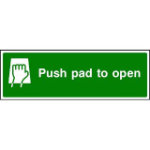 Push Pad to Open Sign
Push Pad to Open Sign
This is another white on green safe condition sign and should be installed with doors that have an emergency escape push pad that is tested to BS EN 179. White text reads “Push pad to open” on a green background.
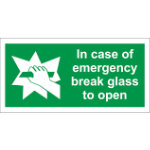 Other Safe Condition Sign Variants
Other Safe Condition Sign Variants
“Slide to open”, “in case of emergency break glass”, “in an emergency turn to open” – these are all variants of white text on green background safe condition signs that are commonly fitted to final exit doors, or in the vicinity of them.
Emergency Exit Signs
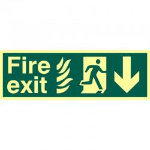 Emergency Exit Sign
Emergency Exit Sign
These signs indicate that the door serves as an emergency exit. They have a white image of a figure running through a doorway, on a green rectangular background, with the words "Emergency exit" or simply "Exit" in white lettering. Some also feature an arrow indicating the direction of the nearest emergency exit.
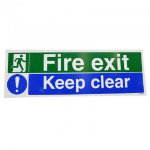 Fire Exit Keep Clear Sign
Fire Exit Keep Clear Sign
These also feature a figure running through a doorway, white text on a green background with the text reading “ Fire exit Keep clear”. The “Keep clear” is mandatory, so this white lettering is on a blue background.
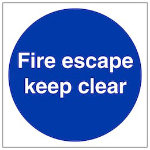 Fire Escape Keep Clear Sign
Fire Escape Keep Clear Sign
This may appear similar to the “Fire exit keep clear signs”, but the fire escape signs are completely mandatory, not half mandatory and half safe condition, so they have white text on a blue circular background. Install them on final exit doors.
Refuge Fire Door Signs
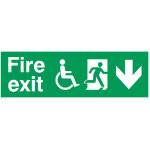 Disabled Fire Door Signage
Disabled Fire Door Signage
These safe condition signs come in a range of options including: refuge point directional signs, refuge point keep clear, evacuation chair signs, and more. These signs indicate that a fire door or fire exit is accessible for disabled individuals. They often display a white image of a wheelchair symbol on a green rectangular background, with a directional arrow and any required informational text.
Fire Safety Signs
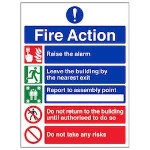 Fire Action Notice Sign
Fire Action Notice Sign
These include refuge fire action notice signs in addition to standard fire action signs. They vary in precise instructions, but all provide a list of actions to take on discovering a fire and often feature empty fields to be populated by specific facilities. These can include details on the location of the assembly point, who is the designated person to contact the emergency services, and where the nearest emergency exit is located.
Design and Material Considerations
Colours and Shapes
Fire door signs typically adhere to standardised colours and shapes for clarity and consistency:
Red and White: Red and white on a white background signifies prohibited actions or danger. When combined with a black symbol they are prohibitory. With white text on a red background, they are fire equipment signs.
Blue and White: Blue indicates mandatory instructions or information.
Green and White: Green denotes safe conditions such as emergency exits.
Yellow and Black: Typically triangular, these are warning signs.
Rectangular Shape: These are commonly for providing additional information.
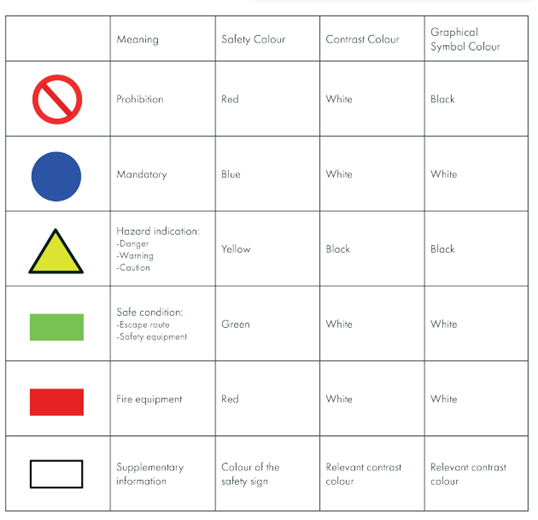
Suitable Materials
Fire door signs should be constructed from durable materials capable of withstanding the environmental conditions of their location. Common materials include:
Self-Adhesive Vinyl: Suitable for indoor use, often applied directly to doors.
Rigid Plastic: A durable option suitable for both indoor and outdoor use. This can be self-adhesive semi-rigid, or non-adhesive rigid.
Photoluminescent Material: Glows in the dark, providing visibility in low-light conditions. This can be flexible vinyl or rigid board.
Metal: Whether this is anodized aluminium, or stainless steel, the base metal can be refinished in colours to suit your facility and other items of door hardware. The text should remain white on a blue background for mandatory fire rated door signs.
Other Materials: Foamed PVC board, polycarbonate, aluminium composite panels, lightweight corrugated plastic can all be used to make door signs.
Signage for the Visually Impaired: Signs that include braille in addition to letters and/or pictograms are typically made from moulded plastic, in a matt finish to prevent reflections. These signs can also be photoluminescent.
Font and Text Size
To ensure readability, fire door signs should feature clear, legible fonts and appropriately sized text. The lettering should contrast well with the background colour to maximise visibility. Helvetica medium is the standard typeface for safety signage.
Text size should adhere to British Standard recommendations for legibility based on viewing distance in metres. BS 5499-1: 2002 states that letter height should be measured by the nominal height of the lower case letter ‘x’.
It is worth noting that signage size is also dependent on light conditions and whether they are within an observer’s line of sight. If a sign is in low light condition and out of a user’s eyeline, then signage would need to increase by 50%.
Maintenance and Inspection
Proper maintenance and regular inspections are essential for ensuring the effectiveness of fire door signs. Here are key maintenance considerations:
Regular Inspection
Routine Checks: Periodically inspect fire door signs and exit door signs to ensure they are in good condition, visible, and correctly positioned.
Replacement of Damaged Signs: Any signs that are damaged, faded, or missing should be promptly replaced to maintain compliance and safety.
Replacement and Repairs
Prompt Replacement: If a sign is damaged or no longer adheres properly, it should be replaced promptly to ensure it serves its intended purpose.
Minor Repairs: In some cases, minor damages may be repairable, but the sign must remain fully legible, in the correct position, and compliant to all relevant regulations.
Conclusion
Fire door signs are a crucial component of passive fire protection and fire safety in the UK. They serve as both identifiers and instructions, guiding individuals during emergencies and preventing the misuse of fire doors.
Understanding the legal requirements, familiarising yourself with the different types of fire door signs, and considering design and material factors is essential for maintaining a safe built environment.
By adhering to UK regulations and standards, conducting regular inspections, and promptly addressing any maintenance needs, you can contribute to a safer environment for all building occupants, reducing the risk of fire-related incidents and injuries. Always consult with fire safety professionals or local authorities to ensure full compliance with fire safety regulations and standards specific to your location.
Fire door signs may seem inconspicuous, but their importance in fire safety cannot be understated.
If you’d like to know more about fire safety and the role fire doors and door hardware play, read our blog: What is Passive Fire Protection? Your Essential Guide.
Contact our sales team today if you need advice on what fire door signs you should be installing in your facility:
T: 01305 263300
E: [email protected]


 Fire Door Keep Shut Sign
Fire Door Keep Shut Sign Fire Door Keep Locked Sign
Fire Door Keep Locked Sign Fire Door Keep Locked Shut Sign
Fire Door Keep Locked Shut Sign Fire Door Identification Discs
Fire Door Identification Discs Fire Door Keep Clear Sign
Fire Door Keep Clear Sign Automatic Fire Door Keep Clear Sign
Automatic Fire Door Keep Clear Sign Push Bar to Open Sign
Push Bar to Open Sign Push Pad to Open Sign
Push Pad to Open Sign Other Safe Condition Sign Variants
Other Safe Condition Sign Variants Emergency Exit Sign
Emergency Exit Sign Fire Exit Keep Clear Sign
Fire Exit Keep Clear Sign Fire Escape Keep Clear Sign
Fire Escape Keep Clear Sign Disabled Fire Door Signage
Disabled Fire Door Signage Fire Action Notice Sign
Fire Action Notice Sign

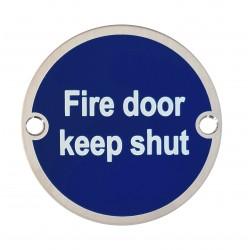
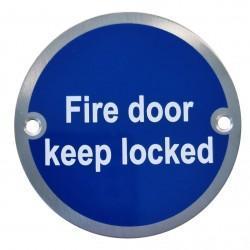
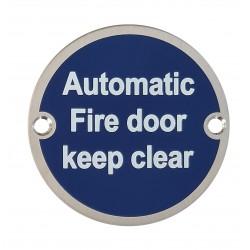


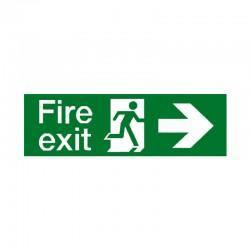
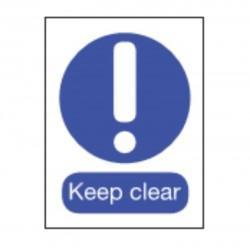
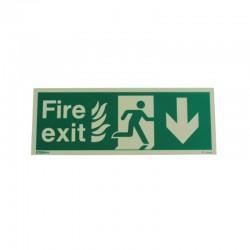
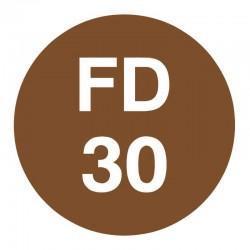
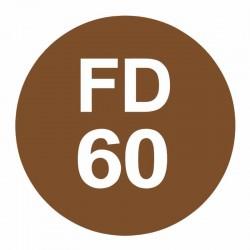
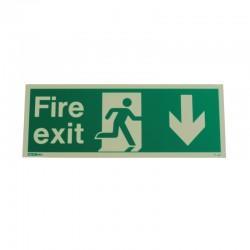





Comments